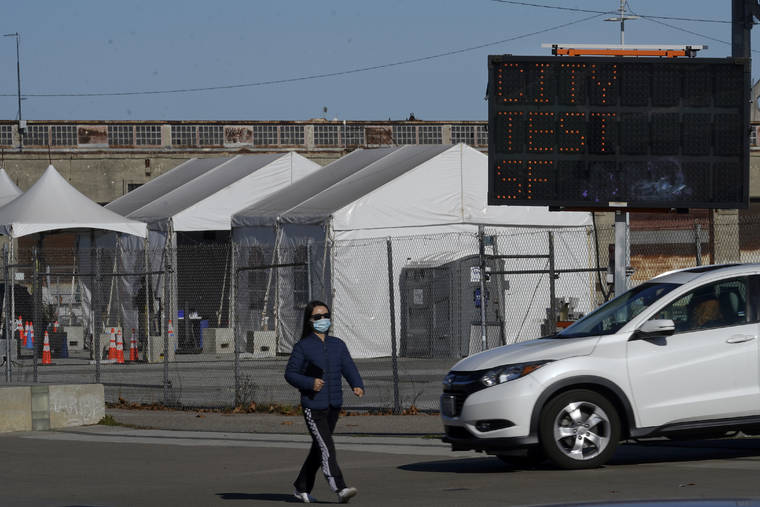LOS ANGELES — California became the first state to record 2 million confirmed coronavirus cases, reaching the milestone on Christmas Eve as nearly the entire state was under a strict stay-at-home order and hospitals were flooded with the largest crush of cases since the pandemic began.
A tally by Johns Hopkins University showed the nation’s most populous state has recorded 2,010,157 infections since January. At least 23,635 people have died from the virus.
The first COVID-19 case in California was confirmed Jan. 25. It took 292 days to get to 1 million infections on Nov. 11.
Just 44 days later, the number topped 2 million.
The California Department of Public Health separately tallied 2,003,146 cases, a one-day bump of 39,070 infections but down from the one-day peak of nearly 54,000 cases at mid-month. The state’s death toll climbed by 351, also down from the record high set last week. Another 427 people were hospitalized, raising the total to 18,875. The 3,962 in intensive care units was a record high, as is the number of those hospitalized.
California’s infection rate — in terms of the number of cases per 100,000 people — is lower than the U.S. average. But its nearly 40 million residents mean the outbreak outpaces other states in sheer numbers.
Dr. Mark Ghaly, secretary of California’s Health and Human Services Agency, said the “sobering milestone” in cases reflects the state’s broad testing efforts along with its large population.
“It is a reminder that this virus continues to spread through our communities,” he said. “Hospitals are full, ICU beds are few, people are dying. The simplest thing we can do, but also the most significant, is to stay home. We are the first line of defense against this virus and we must act now.”
It comes as the COVID-19 crisis strains the state’s medical system well beyond its normal capacity, prompting hospitals to put emergency room patients in tents and treat others in offices and auditoriums, while filling many of its intensive care units to overflowing.
“In most hospitals about half of all of the beds are filled with COVID patients and half of all the ICU beds are filled with COVID patients, and two-thirds of these patients are suffocating due to the inflammation that’s in their lungs that’s caused by the virus,” said Dr. Christina Ghaly, director of the Los Angeles County Department of Health Services.
“They’re suffocating to the point that they can no longer breathe on their own, and they have to have someone put a tube down their throat, in order to oxygenate their organs. Many of these people will not live to be in 2021.”
The state has seen its number of cases climb exponentially in recent weeks, fueled largely by people who ignored warnings and held traditional Thanksgiving gatherings, health officials say.
The milestone prompted new warnings that the state’s medical system will be overwhelmed and unable to provide proper care if people don’t avoid gathering for the holidays or at least take precautions like meeting outside in masks at a safe distance or opening windows and turning on fans if they meet indoors.
“Two million COVID-19 cases in California is a regrettable milestone, and it means that thousands of Californians will spend this holiday season in a hospital,” said Carmela Coyle, president and CEO of the California Hospital Association. “On Christmas Eve, Californians can still make a choice to avoid unnecessary travel and gatherings on Christmas Day.”
In a rare ray of hope, a statistical model that state officials have been using to project hospitalizations predicts more than 71,000 patients in one month’s time — still an unsustainable four times the current number of patients but roughly 40,000 fewer than the same model had been projecting just days ago.
The transmission rate — the number of people that one infected person will in turn infect — has been slowing for nearly two weeks, and it is nearing the point that would bring fewer infections from each person who contracts the virus.
In addition, the rate of positive cases reached a new high of 12.4% over a two-week period, but it was starting to trend downward over the last seven days from a peak of 13.3% to 12.6%. The seven day rate was 12.1% on Thursday.
Gov. Gavin Newsom on Wednesday called the slowing growth rates “a modest indication of a possible sign of some good news.” He credited stay-home orders for nearly the entire state that imposed an overnight curfew, shuttered many businesses and restricted most retail to 20% capacity. Restaurants may only serve takeout.
Pleas to avoid social gatherings for the Christmas and New Year’s holidays rang with special desperation in Southern California. Los Angeles County is leading the surge, accounting for one-third of the state’s COVID-19 cases and nearly 40% of deaths.
“We know that this emergency is our darkest day, maybe the darkest day in our city’s history,” Los Angeles Mayor Eric Garcetti said Wednesday, when the county reported its highest death toll and hospitalizations in a single day since the pandemic began — 145 deaths and more than 6,000 people in hospitals.
More than 9,000 people have died from the coronavirus in the county.
If LA County continues to see the same growth in COVID-19 infections in the next two weeks, hospitals may find themselves having to ration care because of a lack of medical staff, Garcetti said.
“That means the doctors will be forced to determine who lives and who dies,” he said.
————
Thompson reported from Sacramento. Associated Press Writer Stefanie Dazio in Los Angeles contributed to this story.


